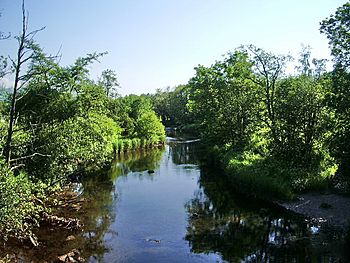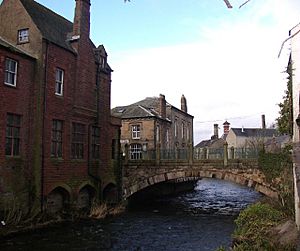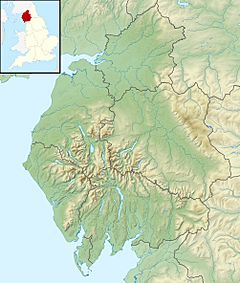River Cocker, Cumbria facts for kids
Quick facts for kids River Cocker |
|
|---|---|
 |
|
|
Location of Cockermouth within Cumbria
|
|
| Country | United Kingdom |
| County | Cumbria |
| Physical characteristics | |
| Main source | Crummock Water |
| River mouth | confluence with River Derwent 54°39′53″N 3°21′54″W / 54.66481°N 3.36511°W |
The River Cocker is a cool river found in the beautiful Lake District in North West England. It's in a county called Cumbria. This river starts way up in the Buttermere valley. It then flows north through Buttermere and Crummock Water. After that, it goes through Lorton Vale. Finally, it reaches the town of Cockermouth, where it joins the River Derwent. The River Cocker is about 12 miles (19 km) long. Its name comes from an old Celtic word, kukrā, which means 'the crooked one'.
Contents
All About the River Cocker
Where Does the River Flow?
The River Cocker begins its journey high up in the Buttermere valley. It flows out of Buttermere lake and then into another lake called Crummock Water. From there, it continues its path north.
The river winds its way through a lovely area known as Lorton Vale. It passes by green fields and small villages. Its journey ends when it meets the larger River Derwent in the town of Cockermouth.
Amazing River Animals
The River Cocker is home to many different kinds of wildlife. It's a great place for fish to live and grow. You can find several types of fish swimming in its waters.
Some of the main fish species include:
- Salmon
- Sea trout
- Brown trout
- Eels
- Minnows
- Sticklebacks
- Stone Loach
These fish rely on the clean water and natural environment of the river to survive.

When the River Flooded
The River Cocker became very well known during the 2009 Great Britain and Ireland floods. This was a time when a lot of rain caused rivers to overflow. The county of Cumbria was hit the hardest by these floods.
Both the River Cocker and the River Derwent burst their banks. This means the water rose so high it spilled out of the river channels. The town of Cockermouth was covered in as much as 8 feet (2.4 meters) of water.
This flood caused a lot of damage. Houses, shops, and workplaces were badly affected. Even the local Cockermouth Cricket Club's home was damaged. It was a very difficult time for the people living there.
Helping the River Stay Safe
After the big flood, people wanted to find ways to prevent such damage from happening again. An important project started in 2014 to help reduce flooding risks. This project focused on the Whit Beck, which is a smaller stream that flows into the River Cocker near Lorton.
The project was called The Whit Beck Restoration Project 2014. It aimed to restore the natural features of the beck. By making the stream healthier, it could better handle heavy rainfall. This helps to protect the areas downstream, including the town of Cockermouth, from future floods.


